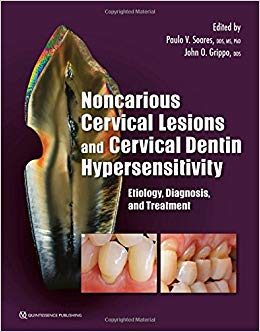
By Paulo V. Soares, John O. Grippo
Hardcover: 208 pages
Publisher: Quintessence Pub Co; 1 edition (April 17, 2017)
Language: English
ISBN-10: 0867157143
ISBN-13: 978-0867157147
Cervical dentin hypersensitivity (CDH) and noncarious cervical lesions (NCCLs) are common findings in modern clinical practice. Although research has shown that NCCLs are a multifactorial condition involving the three mechanisms of stress, biocorrosion, and friction, few dentists know how to treat them effectively. Similarly, CDH has been an enigma for many years, and research has focused on etiology instead of treatment. In addition, little attention has been given to their mutual etiologic mechanisms of cervical stress concentration from occlusal loading and endogenous/exogenous biocorrosion. Therefore, this book approaches CDH and NCCLs together and outlines the history, mechanisms, and, most important, the clinical methods of treatment for these pathologies. It is about time we as dentists learn how to treat and prevent these conditions in clinical practice. This involves greater diagnostic effort and alteration of treatment protocols to (1) reduce dietary intake/exposure to acids, (2) manage reflux diseases, and (3) consider the significance of occlusal therapies. After reading this book, the student or clinician will be able to diagnose and treat clinical cases of NCCLs and CDH.
Contents
Part I Introduction
1. History, Prevalence, and Etiology of NCCLs and CDH
2. Anatomical Considerations: Enamel, Dentin and Periodontium
Part II Mechanisms of Action
3. Friction
4. Stress
5. Biocorrosion
Part III Diagnosis and Treatment
6. Morphologic Characteristics of NCCLs
7. Clinical Analysis and Diagnosis of CDH and NCCLs
8. Nonrestorative Protocols: Occlusal, Chemical, and Laser Therapies
9. Restorative Protocols: Direct, Semidirect, and Indirect Techniques
10. Surgical Protocols: Adhesive Bonding, Materials, and Techniques
Contents
Part I Introduction
1. History, Prevalence, and Etiology of NCCLs and CDH
2. Anatomical Considerations: Enamel, Dentin and Periodontium
Part II Mechanisms of Action
3. Friction
4. Stress
5. Biocorrosion
Part III Diagnosis and Treatment
6. Morphologic Characteristics of NCCLs
7. Clinical Analysis and Diagnosis of CDH and NCCLs
8. Nonrestorative Protocols: Occlusal, Chemical, and Laser Therapies
9. Restorative Protocols: Direct, Semidirect, and Indirect Techniques
10. Surgical Protocols: Adhesive Bonding, Materials, and Techniques
Premium Content
Login to buy access to this content.What's Your Reaction?
Excited
0
Happy
0
In Love
0
Not Sure
0
Silly
0

